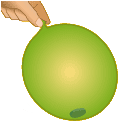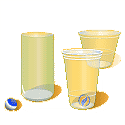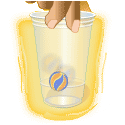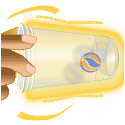




Experiment Category:
Objective:
What You Need:
- Clear helium quality balloon
- Penny
- Small marble
- Collection of jars and cups with various shapes
To Do and Observe:
Part One:
1. Place a penny in a clear helium quality balloon and then inflate the balloon.
2. Hold the balloon in one hand and rotate your wrist. What happens to the penny?
3. Change the rate that you are spinning the balloon (go faster or slower). Does the penny’s behavior change?
4. Change the angle that you are spinning the balloon. Does the penny’s behavior change?
Part Two:
1. Place a marble in the bottom of a cup. Predict what do you think is going to happen when you start rotating the cup.
2. Test your prediction by twirling the cup. Observe what’s happening.
3. Change the rate that you are spinning the cup and observe what happends.
4. Rotate the cup 90 degrees. How do you think the angle is going to affect the behavior of the marble? Twirl the cup and observe. Can you keep the marble in the cup if you rotate the cup a full 180 degrees so the opening faces the floor?
5. Experiment using different shaped containers and observe what happens to the marble
What's Going On:
When an object moves in a circle at a constant speed there are two force vectors at play – one represents its velocity (magnitude and direction) – the direction and the speed of the marble – and the other, called centripetal force, which acts on the object, at a 90 degree angle to the velocity, pushing it toward the center of rotation. It is this force that keeps an object moving along a curved path. If these forces are strong enough they can make an object appear to defy gravity, for example, in a rollercoaster loop or if you spin a marble in a cup and turn the cup upside-down.
In both of the activities the students provided the force necessary to move an object by rotating their wrists. According to Newton ’s Law of Motion, these moving objects will tend to move in a straight line. However, these objects are enclosed in circular containers. As the objects move, they push against the containers and the containers push against the objects. As a result, the objects travel within the containers in a circular path along the walls of the container. If the walls of the container also happen to be slanted, the object will roll along the slant as it pushes outward.
Parent/Teacher Tips:
For Younger Children
You can have a balloon pump available to assist the students with inflating the balloon. Try using larger objects so that the students can see them more clearly, such as marbles or a round piece of candy. If using candy remind the students not to eat it. Make sure that the students have enough space around them so that they do not hit one another as they twirl their balloons.
For Older Children
After the Children have tried the activity with one penny, have them add a penny to their balloon. Have them predict how the behavior of the pennies might be affected. Have the students twirl the balloon again and observe what happens. They can also try putting the marble directly on a table surface and placing a container over it. Challenge children to use the container to lift the marble off the table.
